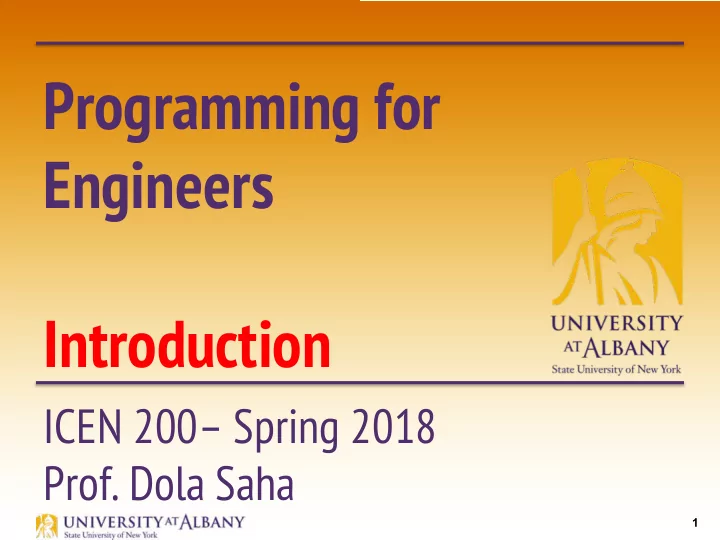

Programming for Engineers Introduction ICEN 200– Spring 2018 Prof. Dola Saha 1
Introductions Ø Instructor § Prof. Dola Saha, PhD University of Colorado Boulder § http://www.albany.edu/faculty/dsaha/ § dsaha@albany.edu Ø Teaching Assistant § Jorge Gomez Ø Students 2
Information Ø Course Website: § https://www.albany.edu/faculty/dsaha/teach/2018Spring_CEN200/2018Spring_CEN20 0.html Ø Blackboard: § https://blackboard.albany.edu/ Course Website Blackboard Lecture Slides Homework Assignments Class Calendar / Schedule Homework Submission Other Information Homework Solutions Announcements Grades 3
Office Hours Instructor Teaching Assistant LI 89B LI 89 Monday – 12:30-1:30pm Tuesday – 12-1pm Wednesday – 11:30-12:30pm Thursday – 11-12pm By appointment 4
Textbooks Ø Required: § "C How to Program, 8th Edition", Paul Deitel and Harvey Deitel, Pearson Ø Reference: § "The C Programming Language", Brian W. Kernighan and Dennis Ritchie, Pearson § "Problem Solving and Program Design in C", Jeri R. Hanly and Elliot B. Koffman, Pearson 5
Assignments & Grading Ø Assignments § No late assignments will be accepted. § All assignments are due by 11:59PM on the due date in Blackboard. § Re-grading requests will be considered up to 5 business days after posting the grades for the corresponding assignment. Ø Grading § Attendance - 5% § Lab Assignments - 15% § Homework Assignments - 20% § Midterm 1 - 20% § Midterm 2 - 20% § Final Exam - 20% 6
Academic Integrity Ø Undergraduate Academic Regulations § http://www.albany.edu/undergraduate_bulletin/regulations.html Ø Academic Dishonesty § Plagiarism, Cheating on examinations, unauthorized collaboration, etc. Ø Practicing Academic Integrity § Citation Ø Penalties for Violation § Warning, lowering grade, failing grade 7
What is Plagiarism? Ø Getting code from the Internet Ø Asking someone else to write the code for you Ø Copying your friend’s code 8
In Class Decorum Ø No use of phones Ø No use of Computers / laptops Ø Computers will be used only when directed in the class Ø DO NOT browse random things in class Ø No crosstalk Ø No Food/Drink Ø Raise hand to ask questions 9
Why this course? 10
By end of the semester Ø Demonstrate basic proficiency in the C programming language. Ø Formulate algorithms to solve basic computational problems. Ø Construct larger programs by identifying and solving sub- problems. Ø Apply basic concepts of software engineering. Ø Apply pointers, arrays, and structures correctly. Ø Apply dynamic memory allocation correctly. Ø Apply basic I/O operations to read and write data files. Ø Understand the basic concepts of algorithmic complexity. Ø Apply basic architectural concepts to program design. 11
Course Calendar Ø https://www.albany.edu/faculty/dsaha/teach/2018Spring_CE N200/2018Spring_CEN200.html 12
Practical use of Computers & Programming Electronic Health Records Ø Human Genome Project Ø AMBER Alert Ø World Community Grid Ø Medical Imaging Ø One laptop per child Ø Cloud Computing Ø GPS Ø Robots Ø Email, Social Network Ø Internet TV Ø Game Programming Ø 13
Computers: Hardware & Software Ø In use today are § more than a billion general-purpose computers, and § billions more embedded computers are used in cell phones, smartphones, tablet computers, home appliances, automobiles and more. Ø Computers can perform computations and make logical decisions phenomenally faster than human beings can 14
Terminology Ø Computers process data under the control of sets of instructions called computer programs Ø These programs guide the computer through ordered actions specified by people called computer programmers Ø The programs that run on a computer are referred to as software 15
Moore’s Law Ø The number of transistors in a dense integrated circuit doubles approximately every two years. 16
Computer Organization Ø Input Unit Ø Output Unit Ø Memory Unit Ø Arithmetic & Logic Unit Ø Central Processing Unit Ø Secondary Storage Unit 17
Programming Languages High Level Language Assembly Language Assembler Compiler Interpreter Machine Language Hardware 18
The C Language Ø Currently, the most commonly-used language for embedded systems Ø Very portable: compilers exist for virtually every processor Ø Easy-to-understand compilation Ø Produces efficient code Ø Fairly concise 19
C History Ø Developed between 1969 and 1973 along with Unix Ø Due mostly to Dennis Ritchie Ø Designed for systems programming § Operating systems § Utility programs § Compilers § Filters Ø Evolved from B, which evolved from BCPL 20
C History Ø Original machine (DEC PDP-11) was very small § 24K bytes of memory, 12K used for operating system Ø Written when computers were big, capital equipment § Group would get one, develop new language, OS 21
C – Built for Performance Ø Operating Systems § Unix, Linux, Android, portions of Windows, OS-X built on Objective C Ø Embedded Systems § GPS, Intelligent Traffic Alert, Robots Ø Real-time Systems § Air traffic control, Industrial automation Ø Communication Systems Ø C-based programming languages § Objective C, Java, Visual C# 22
C Program Development 23
C Program Development 24
C Program Development 25
Environment to be used in class Ø Cloud 9 § https://c9.io § Invitation will be sent to your albany.edu email to join 26
Recommend
More recommend